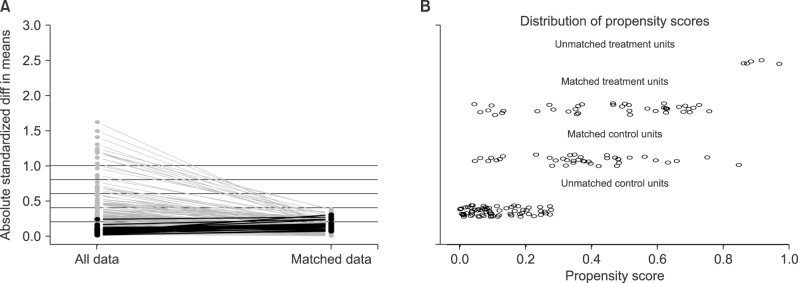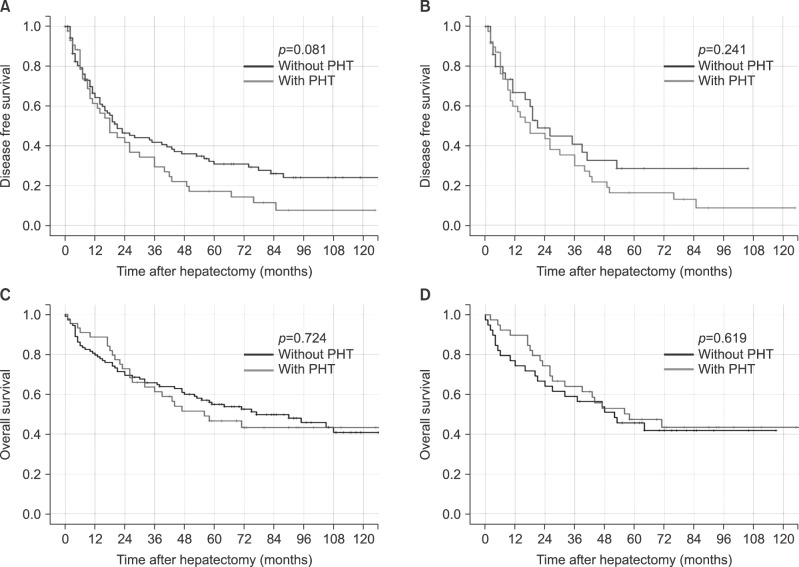Ann Hepatobiliary Pancreat Surg.
2016 Nov;20(4):159-166. 10.14701/ahbps.2016.20.4.159.
Impact of clinically significant portal hypertension on surgical outcomes for hepatocellular carcinoma in patients with compensated liver cirrhosis: a propensity score matching analysis
- Affiliations
-
- 1Department of Surgery, Kyungpook National University Hospital, Daegu, Korea.
- 2Department of Surgery, Kyungpook National University Medical Center, Kyungpook National University School of Medicine, Daegu, Korea. kwonhj95@naver.com
- KMID: 2362465
- DOI: http://doi.org/10.14701/ahbps.2016.20.4.159
Abstract
- BACKGROUNDS/AIMS
The roles of portal hypertension (PHT) on the postoperative course after hepatectomy are still debated. The aim of this study was to evaluate surgical outcomes of hepatectomy in patients with PHT.
METHODS
Data from 152 cirrhotic patients who underwent hepatectomy for hepatocellular carcinoma (HCC) were collected retrospectively. Patients were divided into two groups according to the preoperative presence of PHT as follows: 44 patients with PHT and 108 without PHT. Propensity score matching (PSM) analysis was used to overcome selection biases.
RESULTS
There were no significant differences in morbidity (56.8% vs. 51.9%, p=0.578) and 90-days mortality (4.5% vs. 4.6%, p=0.982) between the two groups. Post-hepatectomy liver failure (PHLF) was not significantly different between the two groups (43.2% vs. 35.2%, p=0.356). Patients without PHT had a better 5-year disease-free survival than those with PHT, although the difference did not reach statistical significance (30.9% vs. 17.2%, p=0.081). Five-year overall survivals were not significantly different between the two groups (46.6% vs. 54.9%, p=0.724). Repeat analyses after PSM showed similar rates of morbidity (p=0.819), mortality (p=0.305), PHLF (p=0.648), disease-free survival (p=0.241), and overall survival (p=0.619). The presence of PHT was not associated with either short-term or long-term poor surgical outcomes.
CONCLUSIONS
Child-Pugh A and B patients with PHT have surgical outcomes similar to those without PHT. Hepatectomy can be safely performed and can also be considered as a potentially curative treatment in HCC patients with PHT.
MeSH Terms
Figure
Reference
-
1. Hidaka M, Takatsuki M, Soyama A, Tanaka T, Muraoka I, Hara T, et al. Intraoperative portal venous pressure and long-term outcome after curative resection for hepatocellular carcinoma. Br J Surg. 2012; 99:1284–1289. PMID: 22864890.
Article2. Bruix J, Castells A, Bosch J, Feu F, Fuster J, Garcia-Pagan JC, et al. Surgical resection of hepatocellular carcinoma in cirrhotic patients: prognostic value of preoperative portal pressure. Gastroenterology. 1996; 111:1018–1022. PMID: 8831597.
Article3. Lisotti A, Azzaroli F, Buonfiglioli F, Montagnani M, Cecinato P, Turco L, et al. Indocyanine green retention test as a noninvasive marker of portal hypertension and esophageal varices in compensated liver cirrhosis. Hepatology. 2014; 59:643–650. PMID: 24038116.
Article4. Boleslawski E, Petrovai G, Truant S, Dharancy S, Duhamel A, Salleron J, et al. Hepatic venous pressure gradient in the assessment of portal hypertension before liver resection in patients with cirrhosis. Br J Surg. 2012; 99:855–863. PMID: 22508371.
Article5. Llovet JM, Brú C, Bruix J. Prognosis of hepatocellular carcinoma: the BCLC staging classification. Semin Liver Dis. 1999; 19:329–338. PMID: 10518312.
Article6. Rahbari NN, Garden OJ, Padbury R, Brooke-Smith M, Crawford M, Adam R, et al. Posthepatectomy liver failure: a definition and grading by the International Study Group of Liver Surgery (ISGLS). Surgery. 2011; 149:713–724. PMID: 21236455.
Article7. D'Agostino RB Jr. Propensity score methods for bias reduction in the comparison of a treatment to a non-randomized control group. Stat Med. 1998; 17:2265–2281. PMID: 9802183.8. Grazi GL, Ercolani G, Pierangeli F, Del Gaudio M, Cescon M, Cavallari A, et al. Improved results of liver resection for hepatocellular carcinoma on cirrhosis give the procedure added value. Ann Surg. 2001; 234:71–78. PMID: 11420485.
Article9. Fan ST, Lo CM, Liu CL, Lam CM, Yuen WK, Yeung C, et al. Hepatectomy for hepatocellular carcinoma: toward zero hospital deaths. Ann Surg. 1999; 229:322–330. PMID: 10077043.
Article10. Poon RT, Fan ST, Lo CM, Ng IO, Liu CL, Lam CM, et al. Improving survival results after resection of hepatocellular carcinoma: a prospective study of 377 patients over 10 years. Ann Surg. 2001; 234:63–70. PMID: 11420484.
Article11. Jarnagin WR, Gonen M, Fong Y, DeMatteo RP, Ben-Porat L, Little S, et al. Improvement in perioperative outcome after hepatic resection: analysis of 1,803 consecutive cases over the past decade. Ann Surg. 2002; 236:397–406. discussion 406-407. PMID: 12368667.12. Ikai I, Arii S, Okazaki M, Okita K, Omata M, Kojiro M, et al. Report of the 17th nationwide follow-up survey of primary liver cancer in Japan. Hepatol Res. 2007; 37:676–691. PMID: 17617112.
Article13. Llovet JM, Fuster J, Bruix J. Intention-to-treat analysis of surgical treatment for early hepatocellular carcinoma: resection versus transplantation. Hepatology. 1999; 30:1434–1440. PMID: 10573522.
Article14. Bruix J, Sherman M. Management of hepatocellular carcinoma. Hepatology. 2005; 42:1208–1236. PMID: 16250051.
Article15. Bruix J, Sherman M, Llovet JM, Beaugrand M, Lencioni R, Burroughs AK, et al. Clinical management of hepatocellular carcinoma. Conclusions of the Barcelona-2000 EASL conference. European Association for the Study of the Liver. J Hepatol. 2001; 35:421–430. PMID: 11592607.16. Imamura H, Seyama Y, Kokudo N, Maema A, Sugawara Y, Sano K, et al. One thousand fifty-six hepatectomies without mortality in 8 years. Arch Surg. 2003; 138:1198–1206. PMID: 14609867.
Article17. Capussotti L, Ferrero A, Viganò L, Muratore A, Polastri R, Bouzari H. Portal hypertension: contraindication to liver surgery? World J Surg. 2006; 30:992–999. PMID: 16736327.
Article
- Full Text Links
- Actions
-
Cited
- CITED
-
- Close
- Share
- Similar articles
-
- 3 Cases of Portal Vein Thrombosis in Hepatocellular Carcinoma and Liver Cirrhosis Treated with Anticoagulation
- Management of Liver Cirrhosis
- Preoperative Evaluation and Postoperative Complications with Prognostic Impact of Surgical Resection for the Hepatocellular Carcinoma in Cirrhotics
- Associating microwave ablation and portal vein ligation for staged hepatectomy for the treatment of huge hepatocellular carcinoma with cirrhosis
- Impact of tumor size on hepatectomy outcomes in hepatocellular carcinoma: a nationwide propensity score matching analysis



